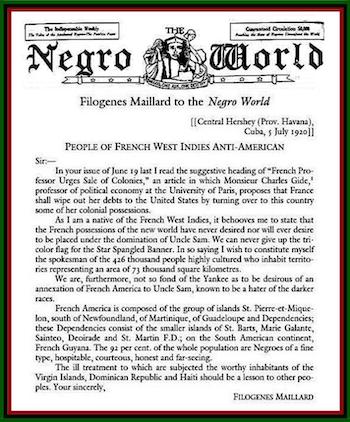
The Negro World, a weekly newspaper with worldwide circulation, was created by Marcus Garvey as the official organ of the U.N.I.A. and African Communities League. The paper was produced in New York beginning in August 1918.
The Negro World preached Garvey's philosophy of black consciousness, self-help, and economic independence.
Each issue featured a front-page editorial penned by Garvey himself; news items covering current events, politics, and the status of black people in the United States and abroad; and reports on U.N.I.A. enterprises such as the Black Star Line.
The activities of U.N.I.A. branches and divisions from Omaha, Nebraska, to Cuba, to South Africa, were reported. And the paper refused all advertisements for skin lighteners and hair straighteners, which were a mainstay of the advertising pages of most African American newspapers.
The Negro World enjoyed a broad and influential distribution, reaching not only the entire United States but the Caribbean, Central America, Canada, Europe, and Africa.
At its peak, the publication had a circulation of two hundred thousand and was the most popular black newspaper in the United States.
Fearing the influence of Garvey's call for independence, European colonial powers banned The Negro World in many parts of Africa and the Caribbean; however, it continued to be distributed clandestinely by black seamen, students, and others.
Over the years, Garvey made the paper more accessible to his constituency: a Spanish language section of The Negro World was begun in 1923, and a French language section in 1924. Amy Jacques Garvey added a page called "Our Women and What They Think" during her tenure as associate editor from 1924 to 1927.
Marcus Garvey was involved in virtually every aspect of the paper.
He was managing editor from the inception of The Negro World on his birthday, August 17, 1918, until his split from the New York division leadership in the early 1930s.
He disavowed responsibility for the editorials that appeared under his name in 1932, and from July 31, 1932, to April 15, 1933, no issues of The Negro World were published.
The paper was briefly revived under the management of M. L. T. De Mena from April through October 1933 (no issues of the paper published after October 17, 1933, have been found).
Eminent black writers and editors who contributed to The Negro World during its heyday included Zora Neale Hurston, W. A. Domingo, Hubert Harrison, T. Thomas Fortune, Arthur Schomburg, John E. Bruce, William H. Ferris, Norton G. G. Thomas, and Eric Walrond.

